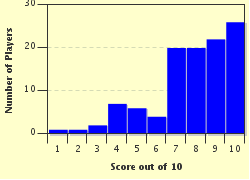Quiz Answer Key and Fun Facts
1. In the mid-19th century, the Whig party had four men serve as President of the United States. Who was not a Whig?
2. Although referred to as a 'party', this group might be more correctly identified as a contemporary movement. It has no central authority and more likely to operate on the local level and as an influence on the national scene. In part based on the ideas and theories of Ron Paul, it links its name to what historical event?
3. The German American Bund roughly began in 1933 but came into prominence in 1936. Its broad purpose was the gain support for German Nazis in the United States. Generally members who joined were of German heritage. In New York, the Bund rallied at Madison Square Garden and paraded with uniforms through the streets. What was the cause of the collapse of the German American Bund?
4. The so-called "Know Nothing Party" appeared briefly on the American political scene during the 1850s. Who was the acknowledged leader of this movement?
5. Theodore Roosevelt left the presidency in 1909 and endorsed William Taft as his successor. However, disenchanted with Taft's performance in office, he sought the Republican nomination for office but the party decided to stick with Taft. Angered by this decision, Roosevelt formed his own party to oppose Taft that he called the Progressive Party. By what name was this party generally called by the public and press?
6. The States' Rights Party, dubbed the Dixiecrats by the press, lasted only a short time in 1948 but it had a powerful impact on American politics. What was that change?
7. What was the name of the multi-millionaire who ran for president in 1992, largely with his own fortune for financing?
8. The Moral Majority was an American political organization. The framers of the constitution provided for protection of the right to worship but it expected those churches to be apolitical--a separation of church and state. In 1979, Christian churches united to form a political force. Basically it boiled down to churches and minsters beginning to endorse candidates who first were Christians and secondly avowed Christian principles in their beliefs and platforms. On the whole those endorsements favored the more conservative elements of the Republican Party.
Who is cited as the architect of the Moral Majority?
9. The Socialist Party of America existed from 1901 to about 1972. It went through a lot of reorganization and shifts in its principles and goals. At its heart it tried to create an umbrella party for organizations and individuals to foster progressive and liberal principles. Who was the famous labor leader who ran for president as a socialist five times?
10. The Libertarian Party came into being through David Nolan of Colorado Springs in 1971. The issues of the party at that time were the Vietnam War, conscription, and the end of the gold standard. As the party developed it took conservative stands on fiscal responsibility while the same time supporting social issues. For instance, they advocate making Social Security voluntary and legalizing drugs. The Libertarians practice clear concise wording of its beliefs in straightforward English with a hint of humor. One party symbol is TANSTAAFL. The first letters stand for "There ain't no such..." What do "TAAFL" mean to Libertarians?
Source: Author
Rehaberpro
This quiz was reviewed by FunTrivia editor
trident before going online.
Any errors found in FunTrivia content are routinely corrected through our feedback system.

